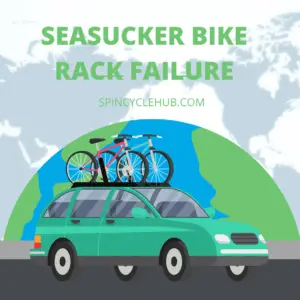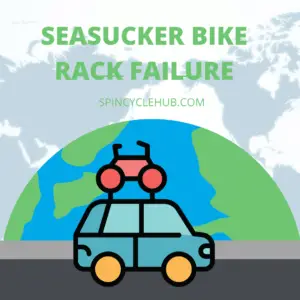Introduction
Transporting bikes has never been easier, thanks to innovative bike rack systems like the Seasucker bike rack. With its unique vacuum mounts, the Seasucker rack offers convenience and flexibility. However, occasional failures have been reported, raising concerns about the reliability of this system. In this article, we will delve into the common issues surrounding Seasucker bike rack failures and provide valuable tips to help you prevent mishaps, ensuring the safe transportation of your bikes.
Understanding the Seasucker Bike Rack
The Seasucker bike rack is a versatile system designed to securely attach your bikes to the roof or rear of your vehicle. Its vacuum mounts provide a strong and stable connection without the need for permanent installations. With its compact design and easy setup, it has gained popularity among biking enthusiasts.

Recognizing Potential Failure Points
To prevent bike rack failures, it’s crucial to identify the weak points of the Seasucker system. By understanding these vulnerabilities, you can take appropriate measures to minimize the risk of mishaps. Some potential failure points include:
– Insufficient surface contact of vacuum mounts
– Overloading or improper weight distribution
– Inadequate strap tension
– Adverse weather conditions
Factors Contributing to Seasucker Bike Rack Failure
Various factors can contribute to Seasucker bike rack failures. One primary factor is improper installation. Failing to follow the manufacturer’s guidelines and neglecting crucial installation steps can compromise the stability and security of the rack. External factors such as strong winds, extreme temperatures, and rough road conditions can also impact the rack’s performance. Additionally, overloading the rack or incorrectly distributing the weight of the bikes can strain the system and increase the risk of failure.
Ensuring Proper Installation
To avoid rack failures, it is essential to follow the manufacturer’s instructions for installing the Seasucker bike rack. Here are some key steps to ensure proper installation:
– Thoroughly clean the mounting surface before attaching the vacuum mounts.
– Apply firm pressure to activate the vacuum seal and test its stability.
– Securely fasten the rack and check for any signs of movement or instability.
– Double-check the tightness of straps and verify that the bikes are securely attached.
Regular Maintenance and Inspections
Regular maintenance and inspections are crucial to prevent unexpected rack failures. Over time, wear and tear can affect the performance of the vacuum mounts and straps. Therefore, it is recommended to:
– Inspect the vacuum mounts for any visible damage or loss of suction power.
– Check the condition of the straps, ensuring they are free from fraying or weakening.
– Replace any worn-out components promptly to maintain the rack’s integrity.
Enhancing Security with Additional Measures
For added peace of mind, consider supplementing the Seasucker bike rack system with extra security measures. While the vacuum mounts provide a reliable connection, using supplementary straps or cable locks can offer additional stability and theft prevention. These measures can minimize the risk of rack failures and ensure the safe arrival of your bikes.
Safety Precautions while Driving
Safe driving practices are paramount when transporting bikes with the Seasucker rack. Here are some tips to keep in mind:
– Maintain a reasonable speed, especially on highways or rough terrains.
– Avoid sudden maneuvers or aggressive driving that may put unnecessary stress on the rack.
– Be aware of low clearance areas to prevent collisions or damages.
Customer Experiences and Anecdotes
Real-life experiences can offer valuable insights into the potential failures and limitations of the Seasucker bike rack system. By sharing anecdotes and stories, we can learn from others’ mistakes and ensure we don’t repeat them. These accounts serve as reminders of the importance of proper installation, maintenance, and safe driving practices.
Customer Support and Warranty
When investing in a bike rack system, it is essential to choose a reputable brand that provides reliable customer support. In case of any concerns or issues, manufacturers with excellent customer support can offer guidance and assistance. It is also important to familiarize yourself with the warranty terms and conditions to ensure proper coverage for your Seasucker bike rack.
Alternatives to the Seasucker Bike Rack
While the Seasucker bike rack system has its advantages, it’s essential to explore alternative options that may better suit your needs. Consider researching and comparing other reputable bike rack systems available in the market to make an informed decision.
Tips for Addressing Common Issues
Even with proper installation and maintenance, occasional issues may arise. Here are some common problems associated with the Seasucker bike rack and tips to address them:
– Loss of suction power: Ensure the mounting surface and vacuum mounts are clean and free from debris. Reapply firm pressure and test the seal.
– Strap slippage: Double-check the strap tension and adjust as necessary to secure the bikes more effectively.
– Rack movement: Confirm that all fasteners and straps are securely tightened and the bikes are properly positioned.
Learning from Experts: Pro Tips for Safe Transportation
Experts in bike transportation can offer valuable advice on ensuring the secure transportation of your bikes. Their insights may include additional precautions, alternative attachment methods, or specific techniques for maximizing rack stability. Pay attention to their recommendations to enhance your overall biking experience.
Case Studies: Success Stories and Lessons Learned
Success stories from individuals who have effectively used the Seasucker bike rack system can inspire and provide useful lessons. By studying these cases, we can gain valuable insights into best practices, proper installation techniques, and maintenance routines that contribute to successful bike transportation.
Conclusion
Preventing Seasucker bike rack failures is essential for the safe and worry-free transportation of your bikes. By understanding the potential failure points, ensuring proper installation, conducting regular maintenance, and practicing safe driving habits, you can minimize the risk of mishaps. Remember to learn from customer experiences, explore alternative options, and seek assistance from reliable customer support when needed. With the right approach, you can confidently transport your bikes and enjoy your biking adventures.

FAQs (Frequently Asked Questions)
- Can I use the Seasucker bike rack on any type of vehicle?
- Yes, the Seasucker bike rack is designed to be versatile and can be used on various types of vehicles, including cars, SUVs, and trucks. However, it is important to ensure that the mounting surface is suitable and compatible with the vacuum mounts.
- How often should I inspect the vacuum mounts for wear and tear?
- It is recommended to inspect the vacuum mounts before every use to ensure they are in good condition. Additionally, regular visual inspections and tests of the vacuum seals should be conducted to check for any signs of wear, loss of suction power, or damage.
- Can I leave the Seasucker bike rack installed on my vehicle when not in use?
- While the Seasucker bike rack can be left installed on your vehicle, it is advisable to remove it when not in use for extended periods. This helps prevent prolonged exposure to environmental factors that may affect the performance of the vacuum mounts and other components.
- What should I do if I encounter a failure with the Seasucker bike rack during transportation?
- In the event of a failure, such as loss of suction or instability, it is important to safely pull over as soon as possible. Carefully assess the situation and take appropriate measures, such as reactivating the vacuum mounts, tightening the straps, or adjusting the bike positioning. If needed, consult the manufacturer’s instructions or contact customer support for further guidance.
- Are there any weight restrictions for the Seasucker bike rack system?
- Yes, the Seasucker bike rack system has weight restrictions that vary depending on the specific model and configuration. It is essential to consult the manufacturer’s guidelines and adhere to the recommended weight limits to ensure the safety and stability of the rack during transportation.
Important Links:
– Seasucker Official Website
– Bike Rack Buying Guide
Watch this one,
Video Credits – SeaSucker [Racks, Marine, & Camp]
DOWNLOAD THIS ARTICLE :Click Here
You May Also Like
-
27 x 1 1/4 Inner Tube Equivalent: Finding the Right Fit for Your Bike
-
A Beginner’s Guide to Thumb Shifters on Drop Bars: Gear Up for Smooth Cycling!



